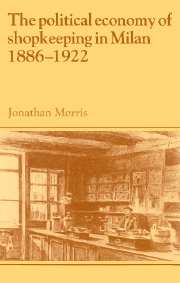Book contents
- Frontmatter
- Contents
- List of figures
- List of tables
- Acknowledgements
- Introduction: shopkeeping as a historical problem
- 1 The business of shopkeeping in Milan, 1859–1915
- 2 The context of shopkeeping: trades and techniques
- 3 The economic geography of shopkeeping: the role of the dazio consumo
- 4 The esercenti enter the political arena
- 5 Constructing the esercenti movement, 1886–1890
- 6 The esercenti and the depression, 1890–1897
- 7 Shopkeepers, cooperatives and the politics of privilege
- 8 Milan and the national small-business movement, 1886–1898
- 9 The allargamento debate, 1895–1897
- 10 The end-of-century crisis and the enlargement of the dazio belt
- 11 Shopkeeping in the new century
- 12 Labour relations and class politics
- 13 The esercenti and the centre-left administration, 1900–1905
- 14 Shopkeepers and Socialists 1905–1922
- Conclusion: identity and autonomy
- Bibliography
- Index
- Past and Present Publications
Conclusion: identity and autonomy
Published online by Cambridge University Press: 24 November 2009
- Frontmatter
- Contents
- List of figures
- List of tables
- Acknowledgements
- Introduction: shopkeeping as a historical problem
- 1 The business of shopkeeping in Milan, 1859–1915
- 2 The context of shopkeeping: trades and techniques
- 3 The economic geography of shopkeeping: the role of the dazio consumo
- 4 The esercenti enter the political arena
- 5 Constructing the esercenti movement, 1886–1890
- 6 The esercenti and the depression, 1890–1897
- 7 Shopkeepers, cooperatives and the politics of privilege
- 8 Milan and the national small-business movement, 1886–1898
- 9 The allargamento debate, 1895–1897
- 10 The end-of-century crisis and the enlargement of the dazio belt
- 11 Shopkeeping in the new century
- 12 Labour relations and class politics
- 13 The esercenti and the centre-left administration, 1900–1905
- 14 Shopkeepers and Socialists 1905–1922
- Conclusion: identity and autonomy
- Bibliography
- Index
- Past and Present Publications
Summary
The esercenti movement in Milan was much concerned with the need to develop a distinctive shopkeeper identity that would, in turn, sustain the movement. Each component part of the movement tried to mould this identity into line with its own outlook, leaving the historian the difficult task of untangling the various strategies proposed by different factions within the movement, and assessing the relative appeal of these to the esercenti. It would be foolish to imagine that a definitive history of the development of a shopkeeper consciousness could ever be written, but analysis of the Milanese movement does provide a concrete context in which the questions raised about shopkeeper history and politics in the Introduction can be addressed.
Throughout the 1880s and 1890s the division of Milan into two different dazio consume zones dominated commercial, industrial and political life in the city. The origins of the shopkeeper movement reflected this division very clearly. It was the mica affair and the continuing efforts of the city administration to raise more revenue from the suburbs that created the circumstances in which L'Esercente and the Federation were able to establish themselves. Their constituency was the proprietors of those stores which would be most affected by changes in the application of the dazio consume: those provisioners of staple goods – such as bakers, pork butchers and grocers – who formed the greatest part of the retail community in the suburban districts.
- Type
- Chapter
- Information
- The Political Economy of Shopkeeping in Milan, 1886–1922 , pp. 285 - 292Publisher: Cambridge University PressPrint publication year: 1993

